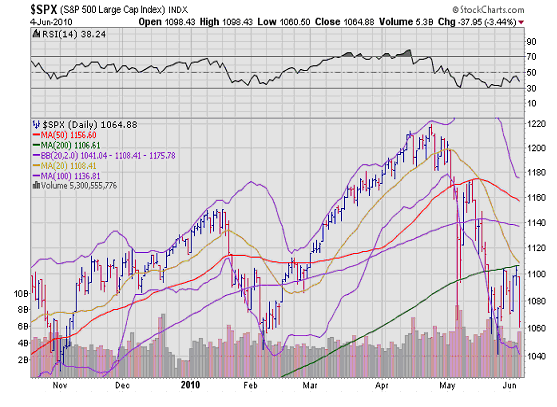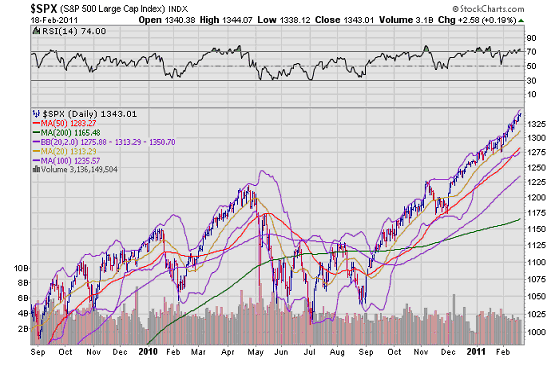Courtesy of John Romero, Aptus Capital LLC
The market is egregiously stretched here with one of two likely outcomes likely to occur:
1) Best case is a 10% normal sell-off
2) Outlier is that another flash crash is certainly possible as conditions are near perfect
In my opinion being too overly anticipatory is a recipe for disaster because timing actual moves is so challenging in our momentum-based HFT world. I am not going to repeat the old cliché that “the market can stay irrational longer…” but any investor that has suffered big losses usually has been too inflexible or been unwilling to modify their original thesis when the facts suggested otherwise. It is human nature to have a bias towards whatever positions you have at the time but it is also healthy to clear things out from time to time so you can get a fresh objective perspective.
I am not going to beat a dead horse on why the market is due for a pullback or how overbought it is relative to a healthy environment that has a normal ebb and flow. Any remotely experienced investor that is focused on absolute, not relative, returns recognizes that we are in an unsustainable market advance and a sell-off is not a matter of if, but when. After all, in the trading environment world that we have been in for 10 years, it is not so much what you trade but when because timing is everything. Market action repeats itself over and over so let’s take a look at the environment preceding the flash crash of Thursday, May 6, 2010 because things look awfully similar if you step away from the punch bowl.
The market had gone on a large and persistent run from somewhat oversold conditions that had developed in late January/ early February 2010 as a result of the typical profit taking that sets in the middle of January after the 4th Q rally. Seasonality starting in the middle of January for a month or so is generally not kind to growth investors as the QQQQ stocks really tend to struggle. The market peaked around 1/20/2010 and subsequently lost about 10% peak to trough where it bottomed around 2/5/2010. From there it went on to make about a 15% run until 4/16/10 where it lost about 1.5% for its first big down day. During this rally the market was consistently overbought on an RSI basis that was finally worked off on that first down day. On a daily chart this 15% run in terms of daily volatility looked very narrow. In an overbought momentum driven market, the first dip after a big run is almost universally bought. It is extremely unusual for it to fall out of bed without a vigorous attempt at buying the first dip- the true trouble emerges when that buy the dip rally fails like it did without making more than a marginal new high attempt on 4/27/2010. Around this time the market started to chop with extra volatility which worked off the RSI level in short order. In my opinion, this set the stage for the sell-off to really gain steam.

What is particularly interesting is how the turn of the month calendar played a role. The market was up nicely in April and towards the end of the month investors decided to lock in profits. It is extremely unusual for the market to have a huge loss on the first trading day of the month, but usually weakness sets in on the 4th or 5th trading day of the month. True to form the market rallied 1.3% on the first trading day in May which was Monday, May 3rd- and provided another opportunity for weakness to kick in on Tuesday and Wednesday setting up for an oversold bounce into weeks’ end. On Thursday, May 6th, when the bounce did not materialize investors and traders ran for the hills and a mini crash ensued with the Dow losing roughly 1000 points at the low of the day. People love to blame HFT, et al., but at the end of the day, the world is a momentum investor so when it was down 2, 3 and then down 4% in short order, all the bids went away.

What caused this?
People love to blame HFT, faltering technology at exchanges, market makers, etc., but at the end of the day you can look no further than an egregiously overbought market environment that needed to consolidate. On many levels, today’s environment is sadly worse off than the climate that immediately preceded the May 2010 flash crash.
1) The market has been in a relentless slow moving grind for months with no normal ebb and flow- The weekly RSI reading on the SPX is higher than it has been since 2004 confirming the ridiculous rise.
2) The market is not based on underlying fundamentals but by investors believing the Fed will continue to prop it up, they are buying for speculative not fundamental merit
3) Lack of confidence in the integrity of the equity markets
4) Yields are on the rise with the 10 year having risen over 100 BPS in recent months
5) Negative seasonality and the reality that QE II is closer to the end than the beginning
At the end of January, we just missed a chance for a nice profit taking opportunity to work off the overbought conditions with a 1.5% sell-off but we did not get it—it was virtually identical to the days before the flash crash but when it made that marginal high, it continued to chug on. Remember that normal profit taking is healthy, it allows for healthy measured moves by allowing investors in and out as opposed to all in and all out. This is how the market makes sustainable moves higher, by forming solid areas of foundation that can be trusted.
So here is the next set up that could crush the current uptrend – the market has a gentle sell-off starting this week and then has a brief respite on Tuesday, March 1st with turn of the month buying. If the market cannot make a marginal new high from its first dip buying effort in early March, look for huge weakness to set in.
No comments:
Post a Comment